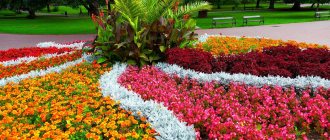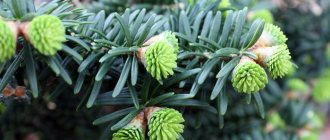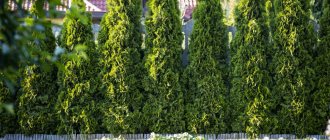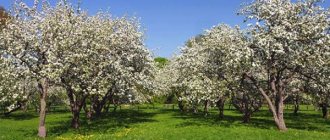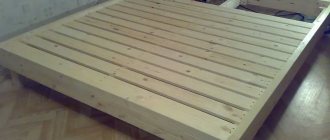If you have just purchased a garden plot and are new to gardening, the question quite naturally arises of what to plant your garden with.
To answer this question, it is not enough to provide a list of vegetables and berries, because there are many crops cultivated in Russia.
So start by answering five questions:
- What are your and your family members’ preferences in vegetables and berries?
- Do you want to grow crops for storage, canning - with a reserve, or just for the summer-autumn season, to eat fresh food?
- Can you maintain your garden every day, every other day, or just two days a week?
- How well does your site receive sunlight?
- How suitable are the climatic conditions for growing vegetables and berries?
Why these five questions? Because everything else that may arise is solvable. For example: the quality of the soil and the proximity of groundwater are very important for planting a vegetable garden, but this topic can be dealt with if desired. The soil can be improved, the area raised, and drainage provided. But if the garden area is shaded by tall trees, the sun rarely appears or only through the veil of openwork foliage of pine and birch trees, no matter how hard you try, you will not be able to grow all the crops.
How to use perennials in the country: main features
Perennials are plants that have a long period of growth and flowering. Such ornamental crops do not need to be planted every spring. It is enough to water them and monitor the root system so that rodents do not damage them.
Most perennial garden plants begin to bloom in early spring, as soon as the snow cover melts, while newly planted seeds sprout in about a week or two. This is due to the fact that most ornamental crops are adapted to cold winters, since the root system is not subject to freezing.
Poppies and marigolds in a hanging flowerbed at a summer cottage Source dizainexpert.ru
Coniferous and deciduous perennials for gardening for planting in rock gardens Source dizainexpert.ru
Different types of plants are used for a garden plot in a country house. All of them can be components of various compositions:
- rock gardens;
- hanging panels;
- living walls;
- multi-tiered objects;
- sculptures made from living vegetation.
All perennial crops are often used en masse for suburban home areas. They can serve as the basis of a flower garden or be its decorative addition. If you combine them correctly, they create an incredible accent on the site.
A climbing perennial plant for the garden that creates shade on the terrace Source dachnik0ff.ru
How to make a mixborder from conifers and shrubs: ready-made flower bed schemes
A mixborder of conifers and shrubs serves as a classic example of the use of plants. Such “flower beds” are located in different areas:
- near outbuildings;
- along fences;
- near houses.
Coniferous plantings in such a flower garden play the role of a “skeleton” that determines the height and outline of the entire composition. Therefore, these crops are planted in the background of the mixborder, which is located near the walls.
Mixborder in the yardSource vk.com
The central place is given to conifers when arranging combined compositions in free areas. The lower tier of such a flower garden can be occupied by:
- lilac;
- hibiscus;
- magnolia;
- elder.
When creating a mixborder from conifers, when supplementing it with broad-leaved forms, one should take into account the intensity of growth processes in broad-leaved shrubs, preventing them from exceeding coniferous ones.
Well-chosen plantsSource www.galangpratama.com/
Why perennials?
Having found out that perennial plants are considered unpretentious, you can use them to form any landscape decorations. Also, a large number of gardeners believe that such plant options are ideal for a private yard for several impressive reasons:
- The attractiveness of the decoration will be present throughout the entire summer season. Typically, perennials bloom all season long: some inflorescences are replaced by others, and the finished flower garden will remain unchanged for several years.
- There is no need to regularly replant crops, dig up roots, or re-sow the area with seeds. The only thing that needs to be done is weeding the soil to remove weeds, otherwise they will turn the decor into an object with an incomprehensible structure.
- Almost all perennial garden crops are resistant to low temperatures, heat and changes. In such conditions they do not die, even if there is no watering for a long period.
- There are practically no financial expenses required. Sown plants will not require numerous fertilizers and various types of fertilizing. It is enough to simply plant them in fertile soil and enjoy the beautiful flowering.
From already growing perennial crops, you can collect ready-made planting material: seeds, cuttings, bulbs, seedlings.
Shade-loving perennial astilbe for the garden Source dachnik0ff.ru
On a note! It is not necessary to buy new varieties of perennial plants for your garden yourself. You can organize an exchange of cultures with your neighbor in the country.
Selection of trees according to climate zone
Before purchasing seedlings, choose them rationally. Southern heat-loving specimens quickly die or do not take root at all in cold areas. Gardeners often unsuccessfully try to grow fruit crops that are sensitive to air temperature in their dachas.
Trees for northern latitudes
Among the decorative representatives of the flora, the following common species tolerate cold climates well:
- black or Russian willow
- broom
- Rowan
- white acacia
- birch (various varieties)
- blue spruce
- Norway maple
- thuja
- oak
- Amur velvet
Things are more difficult with fruit trees. Most of them die in icy winters. Pay attention to nuts, resistant varieties of apple trees, hawthorn, lingonberries, and blueberries. Now there are other fruit crops on the market that are adapted to harsh conditions.
Trees for mid-latitudes
In the temperate climate zone, the choice for planting green spaces is huge. Broad-leaved (beech, ash, linden), coniferous (spruce, pine), small-leaved (aspen, birch) species, as well as most fruit representatives, take root well.
If severe frosts occur in mid-latitudes, they last only a short time. In temperate zones, temperatures can drop to -25-30 C. Therefore, choose plants that can withstand such cold weather.
Trees for the south lane
Warm weather conditions with little temperature variation are the ideal place to create a fertile garden.
In the south, heat-loving plants develop and bear fruit well:
- peaches
- apricots
- cherries
- pears
- quince
- cherries
- dogwood
- sea buckthorn
- barberry
- mulberry
- honeysuckle
- plum
When choosing seedlings, objectively assess the climate in which the plant will have to live. Buy the most adapted varieties. Don’t give in to the desire to do the impossible and grow something completely exotic.
Bulbous plants
These are fairly unpretentious crops that even a novice gardener can plant. Such crops will quickly grow stronger and produce their first stems and flowers next spring. Flowers do not require watering and care. The only condition is to plant them in airy, well-drained soil. To achieve this, before preparing the bed in the fall, you need to dig up the planting site with sand or small pieces of expanded clay. There are gardeners who prefer to add polystyrene foam.
Let's consider which plants can be classified as bulbous and how to look after them in all seasons.
Bulbous perennials: hyacinths in a country flower bed Source domikru.net
Tulips
A fairly common plant that can be found in flower beds around the house. Its planting is carried out in late September-early October. If the bulbs are purchased in advance, they should be stored until September at a temperature not exceeding 20 degrees. As for lighting, a seat is suitable both in partial shade and in bright sunlight.
Watering the plant should be plentiful. For example, at the time of buds setting and their further blooming, it is necessary to spend from 10 to 30 liters of water. But, do not flood the plant. Indeed, in conditions of high humidity, the bulb quickly rots and the crop dies.
White tulips for decorating flower beds in a summer cottage Source artfile.ru
Daffodils
Planted in August or no later than the first days of September. Planting material must adapt to the soil that is prepared for it. It is advisable to apply a small amount of organic fertilizers: manure, peat, compost, sapropel.
Planting different varieties of daffodils in a country flower bed Source 1zoom.ru
Watering the plant for the first time is carried out after the sprouts appear, as soon as the moisture remaining from the snow cover is gone. If the winter was dry, then the crop should be watered as soon as the frost subsides. Moreover, watering should be moderate and regular. Plants should not be overwatered. Daffodils grow well in shade and partial shade and are not afraid of bright sunlight. The plant does not need annual replanting; for the next flowering season it produces a “baby” from which a young flower emerges.
On a note! Often, propagation of daffodils is vegetative (that is, using bulbs), and sometimes seeds are used, followed by transplanting the grown seedlings into the ground.
Hyacinths
Hyacinths are very colorful and beautiful flowers. They are easy to grow and require absolutely no maintenance. The planting location should be sunny but partially shaded. For example, let it be light in the flowerbed in the morning, and in the afternoon the shadow falls. But, make sure that the chosen area is protected from the winds.
Hyacinths in a flowerbed Source lanshaft.com
Before planting, it is advisable to mix the soil with compost. It is important that the fertile layer is not acidic and very wet. It is better to wrap the bulbs in the holes in straw. This approach is important for capricious varieties of hyacinths. It is worth watering perennials abundantly (but without fanaticism) in the spring from the moment the first stems appear. Before the arrival of summer, the amount of watering is reduced, and during the hot season you need to moisten the soil once a week so that the root system does not dry out. After flowering, the inflorescences are pruned so that they do not form seeds, because this period seriously disrupts the nutritional balance, which can affect the development of the plant in the next season.
Crocuses
Crocuses are conventionally divided into groups: spring-flowering and autumn-flowering. The first decorative crops are planted in the autumn, the second - in the summer. Flowering lasts for 2-3 weeks. The plant reproduces by daughter bulbs. It is best to plant perennials in loams and even heavy clay soils.
Perennial crocuses in a flowerbed at a summer cottage Source lanshaft.com
Fertilizers for crocuses are applied in the spring using mineral fertilizers, and during flowering - potassium-phosphorus fertilizers. Organic compounds are not introduced during any of the growing seasons of perennial ornamental crops. Often propagated by daughter bulbs or even seeds (provided they are spring-flowering varieties). Flowers practically do not need watering. Moisten the soil only if there was no snow in winter.
Primrose
To plant primroses, you must choose a semi-sunny area. This could be the north side of the house. You should definitely make sure that there are no drafts in this place. It is desirable that in the summer there is shade from deciduous trees in the primrose planting area.
Beautiful flower beds with yellow primroses on a summer cottage near the house Source 1zoom.net
A perennial plant is first prepared (grown in containers) and its roots must adapt to the outdoor environment before summer. Planting is carried out in July-August. There are no special requirements for caring for perennials, but watering must be regular. Moreover, it should be done no more than once a week. It is advisable to give the soil up to 10 liters of water at a time.
On a note! If the plant is flowering, then it is better to fertilize it every two weeks. This way it will look more lush, beautiful and rich.
Grouse
Another variety of bulbous plant that can often be found in the home garden. It is better to plant hazel grouse on the sunny side, but with plenty of shade. Before planting, you need to re-weed the area and add humus or peat. Then plant the bulbs with a formed root system. You can also add ash or lime to the soil.
During the dry summer period, you need to water the hazel grouse bush every evening. At the same time, it is important to ensure that the top layer of soil does not crack, but remains loose at all times. This is necessary so that the roots, like the bulb itself, can receive sufficient oxygen. After the end of the growing season, watering is carried out no more than once every 2-4 weeks.
Growing slender hazel grouse of different colors in a summer cottage Source 1zoom.net
Important! If the plant does not bloom, perhaps the summer period last year was unfavorable for it. It is a mistake to mistake this state of the plant for pain and exposure to pests.
We are planning landings
- Draw a plan of your site on graph paper, to scale. Format no smaller than A3. No need to sketch by hand on your knee, take accurate measurements. You will need a tape measure and an assistant.
- Mark on the site diagram all existing and planned buildings: house, barn, utility rooms, swings, gazebos, barbecue area or pool, all flower beds, compost heap. We separately note the vineyard (if there is one or planned).
- Make a copy of the site plan, for example, on tracing paper or redraw it, photocopy it, as there may be several options.
- In the entire space free from buildings and flower beds, select zones based on illumination: the sunniest places and the shady ones. To do this, take a day and look carefully at where the shadows of trees and buildings fall.
- Mark the water source.
- Choose places where you can put greenhouses or a greenhouse - these are the widest areas. Consider the distance between paths and rows. The passage for a wheelbarrow should be at least 50-60 cm; the larger the area, the greater the width of the paths you can afford. But if the plot is small, it all depends on your appetite: are you ready to make do with 30-centimeter passages between the beds or do you need more to turn around while weeding.
- If you have made a large list of planned plantings in the garden, it is better to make more narrow beds of 45-60 cm than wide meter beds.
Other types of perennials
There are plenty of varieties of perennial ornamental plants for flower beds. Let's consider more options that will look original on the local area, decorating it with their inflorescences.
Various beautiful varieties of perennial plants near the house Source 1zoom.net
Assium is small and quite tenacious
Assium is an interesting ornamental variety that can be planted in arid regions. In addition, in winter it does not freeze out in case of persistent frosts. The root system, like the stems, can withstand harsh conditions. There is no need to regularly fertilize and care for the crop. The plant is used in:
- rock garden organizations;
- formation of flowerpots and living panels;
- creating living small borders around flower beds;
- landscape objects in need of ground crops;
- other elements on personal plots.
A perennial plant with pleasant delicate colors, and its flowers have a pleasant, unsaturated aroma. The plant should be planted in places with excess sunlight. It is often a complement to paved slab fences. During the flowering period, the plant becomes lush; it perfectly fills the crevices of alpine hills and diversifies the paths in the local area.
Assium is a perennial plant for rock gardens and flower beds Source happymodern.ru
Pansies - incredibly bright and attractive
Pansies are a popular and fairly widespread plant. It is distinguished by a large number of colors and adaptability to growing in sunny places. Also, moist loamy soil is quite suitable for the plant. This perennial is used for organizing:
- bright multi-varietal flower beds;
- rock gardens;
- rockeries (in small quantities);
- decorating street stairwells;
- decoration of terraces (by hanging in flower pots).
Viola or pansy does not tolerate low-lying soil. Water constantly stagnates here, which means the plant’s root system can rot. Under no circumstances should you introduce fresh manure fertilizers during the flowering period of the perennial. It is better to remove the resulting seed boxes; as a result, the flower life will increase. If this is not done, the plant will waste energy on the formation and maturation of seed pods.
Decorating the garden near the house with pansies of different varieties and shades Source florino.net
Anemones - various colors
Anemones are beautiful multi-colored perennial crops for home flower gardens. They attract attention with their diversity. They are used to decorate landscape designs, and different tones of flowers can be simultaneously contained in one place in the front garden. Features of growing ornamental crops:
- It is better to plant the plant to a depth of no more than 5 cm;
- You should choose an exclusively sunny place;
- regular fertilizing is needed only in infertile soils;
- It is best to apply complex fertilizers twice in the summer season.
Anemone flowers are used to create colorful gift bouquets.
Cute asters
Asters are quite an attractive perennial plant. It has many colors and is unpretentious. That is why novice gardeners often choose it for growing. It grows almost all year round: starting from late spring until the season when the first frosts occur. The requirements are quite primitive:
- high-quality regular watering;
- planting in partial shade and even in a sunlit area;
- use of organic and mineral fertilizers for fertilizing;
- light, permeable soil is preferred;
- replanting once every 5 years.
This plant is intended for forming the edges of paths, as well as as the basis of various designer flower beds. Less commonly, these plants are planted in large pots or special containers.
Landscaping design at the dacha with asters in the flower beds Source ru.gde-fon.com
Fairytale periwinkle
This plant attracts so much attention that it is difficult to tear yourself away from the beauty of its flowering. But, such an effect is possible only if proper care is taken and all conditions regarding growth are met. The perennial quickly grows in width, so it fills large spaces. Vinca leaves have an interesting, easily visible structure. Features of growing a perennial crop:
- rapid formation of the horse system when growing in partial shade;
- the shade of the leaves changes depending on the intensity of sunlight;
- For normal development, you need to regularly moisten the soil.
The perennial takes root well in the vicinity of hyacinths, proliskas, primroses, and heucheras.
Bergenia for open soil
This plant has attractive colors, looks great in any type of rock garden, and does not require serious care. However, for the normal passage of the growing season it is necessary to grow strictly in partial shade. Used to form:
- flower beds of different geometric shapes;
- design of curbs and curbs;
- front gardens in front of the house.
The plant is very sensitive to temperature changes. But, if it manages to survive the cold winter, then in the spring it will be exposed to viruses and fungi. To avoid this, it is necessary to fertilize the bergenia and treat the leaves with protective preparations from early spring.
Colchicum - twin of crocus
In terms of external characteristics, the crocus will be similar to a crocus, which is properly cared for. The plant survives the winter cold well and becomes strong and attractive. It has large flowers with a rather pleasant and delicate aroma. Features of the growth of colchicum are as follows:
- flowering within 3-4 weeks;
- there are no conditions for selecting soil;
- no growth enhancers required;
- planted on alpine hills and ordinary flower beds.
Colchicum undergoes pollination by bees, after which the flowers of the plant begin to fade. Subsequent flowering will begin the next season.
Perennial colchicum in a summer cottage Source lifehacker.ru
Loosestrife or lysimachia
Gardeners choose this perennial plant for their gardens for its slenderness and unusual beauty. It fits perfectly into different types of flower beds, and its pink or yellow inflorescences will highlight the colorfulness of the landscape design. Let's consider the features of cultivation:
- abundant and regular watering;
- sufficient sunlight;
- fertilizing with mineral fertilizers twice a month;
- no winter insulation required.
Please note that there are many varieties of loosestrife and only some of them prefer to grow in partial shade. At the same time, even here it is necessary to maintain soil moisture.
Yellow loosestrife on a summer cottage adjacent to the house Source lisky.org.ua
Astilbe - for soil rich in humus
Astilbes come in several varieties. Their care features may differ depending on the variety. This plant comes in short, medium and tall heights. Each of them is used to decorate various landscape objects. The flowers are inflorescences in the form of panicles of varying heights. Features of caring for decorative perennials include:
- regular watering with settled water (in severe drought, 2-3 times a week);
- area selected in partial shade;
- It is necessary to remove flower stalks after flowering (their presence does not allow the plant to develop normally);
- monitoring the temperature of the soil layer (overheating can lead to the death of the root system).
Astilbe often has bare roots throughout the winter. So, so that they do not freeze and the plant does not die, it is necessary to cover them with a special warming material.
Bright pink astilbes for the garden near the house Source dekorsad56.ru
Gazania - blooms only in summer
Another very beautiful perennial. It blooms exclusively at the onset of the summer season. The plant has many colors, they can even be combined when planted in the same flowerbed. Famous designers have nicknamed the perennial crop the South African daisy. You can grow decorative perennials in:
- rock gardens;
- boxes;
- special containers;
- flowerpots or pots.
Often this type of plant is used to decorate borders, along various paths in local areas. Often these flowers are used to create flower beds directly on lawns and carpet plants. In order for gazanias to grow well and delight their owners with their flowering, it is worth choosing well-lit, open, but windless places for planting them. A living fence with coniferous ornamental crops will serve as a good savior from drafts for these plants.
Note! Stagnation of moisture in the soil where gazania grows is undesirable. Watering, even during dry periods, should be moderate.
What to plant in a large area. Planning
Before planting an orchard, it is recommended to make at least a rough plan for planting trees. Having made sketches on paper, you can personally imagine how the site will look in general terms.
There are two types of planning: landscape and regular.
Adherents of geometric clarity and orderliness of forms will enjoy a garden in a regular style. In it, trees and berry bushes are planted in even rows at equal intervals. Garden beds are laid out in the shape of regular rectangles and squares, separated by smooth paths laid in straight lines. With this arrangement, you always know what is where, and it is easier to care for the plantings.
Approximate plan of a summer cottage with an area of 6 acres: 1 - house; 2 - garage; 3 - household yard; 4 - place to rest (gazebo); 5 - lawn, flower bed; 6 - front garden; 7 - planting strawberries; 8 - vegetable garden; 9 - garden
Landscape, or free planning, is close to the natural style. Plants are planted according to a pre-designed scheme, but are not arranged in a strict order, but in groups. Along with fruit trees and shrubs, ornamental vegetation is used, and vegetables can coexist with flowers. Creating a landscaped garden requires creativity.
The ratio of the garden area to the area of the plot is a relative concept and depends only on the owners of the land plot. No one has established standards for the balance of the territory, so an orchard can occupy more than half of the territory (if the owner wishes this), or it can be tiny and consist of only 3-4 trees.
Helpful advice. If there is not much land for a garden, but you want to plant more trees, additional “land resources” are found. You can plant 2-3 fruit trees in the front garden, located between the facade of a residential building and the fence. With a small front garden, it is permissible to use the space behind the fence, however, here you can plant not very valuable types of trees, the fruits of which there are not many hunters: mulberry, apricot, summer apple tree, Hungarian plum, simple cherry.
Unpretentious perennials that bloom all summer
Each perennial plant for the garden has its own flowering time. Let's look at the list of those that will delight the owner with their beautiful colors throughout the summer.
- Echinacea. It has rather rigid stems and grows up to 1 meter in length. The flowers contain a spiny basket and sharp petals. Comes in different colors. It blooms from July to September and has a pleasant delicate aroma. Requires fertile soil and regular watering. You need to plant 7 flowers per 1 square meter.
- Poppy. More often considered as a weed. Grows in meadows and fields. It is distinguished by the presence of several varieties, many of which are available for planting in the local area. Gray-green leaves are located on a long, fragile stem. Poppy seeds are planted in March without prior soil preparation. The culture prefers permeable substrate soils and loves water.
- Physostegia. The plant was first distributed in America; today it is popular to grow in the southern regions of Russia. The shoots of the crop are straight, reaching a height of up to 70 cm. It blooms during July-September. The perennial is considered undemanding; planting is carried out without any fertilizers. One-time fertilizing can be applied during the growing season. Blooms come in a variety of shades, from soft pink to purple and lilac.
- The largest cornflower. In appearance it resembles a large chamomile and is practically odorless. The plant requires fertile, fairly moist soil. Under the right growing conditions, the crop gains a height of up to 70 cm. It blooms with white flowers with a yellow basket from July to September.
- Berry kniphophia. This is an exotic perennial that pleases the owner of the house with its flowering all summer long. The inflorescences are separated by shade: yellow below, red above. The crop should be planted on fertile soil and well-lit areas. It is better to place them in the flowerbed in small groups - 5 pieces each. Otherwise, they will not have time to feed on substances from the soil, and the inflorescences will become small.
- Flat-leaved eryngium. A beautiful ornamental plant with unique flowering. In appearance, the bud looks like a weed. The eryngium is accustomed to growing in dry soils. It reaches a height of about one meter. There are no conditions for growth, as it can survive in wastelands for many years. For the correct growing season, human intervention is not required. They look good in dense flower beds and on alpine hills. It blooms from the onset of warm weather until the first frost.
On a note! Try to grow plants that provide color all summer long in beds with turfgrass or carpet varieties. From the outside, such a design will be colorful and rich.
Optimal bed sizes
The beds need to be planned in such a size that they are easy to care for: sowing, planting seedlings, weeding and reaching with a watering can.
Therefore, the ideal dimensions are width 80 cm, length 3-4 m, height 35 cm (for beds with a fence). If you have a lot of children’s helpers, for example, during the holidays, grandchildren and children help with weeding, then the best width is 70 cm.
With such dimensions, it is convenient for everyone to reach with their hand from each side of the row spacing to the middle of the bed.
The maximum permissible width of the bed is 1 m, for cabbage, which is planted in two rows, 100-120 cm can be allocated. The width of the rows is at least 30 cm, optimally 40 cm, if a wheelbarrow needs to drive up to the bed, then 50 cm. These dimensions are for a small vegetable garden , where every centimeter is precious. If your area is quite large, feel free to leave passages 60-80 cm wide.
A small selection of perennials at last
Ornamental crops that can grow in one place for decades may lose their attractiveness over the years. This is due to the fact that the soil releases useful substances, and the root system has nothing else to feed on. In this regard, we offer several varieties of varieties that are resistant to transplantation and are able to exist in the soil without losing their appearance, even if its composition is critical:
- Oregano. It mainly grows in the European part of the country. The first greenery appears in March, has a pleasant, unobtrusive smell and beautiful lilac flowers. Grows in different soils.
- Lofant or multi-column. Spicy and good-smelling plant. Plays the role of a decorative and medicinal crop. Without much effort, it takes root in illuminated areas and can develop in light soils.
- Monarda. It is distinguished by a large number of varieties of inflorescences. They try to plant such a perennial with other similar plants. Culture will become a luxurious backdrop for other cultures. Combines with diphinium and light blue bells.
- Phlox. A bright and unpretentious contender for a place in your flower garden. They winter well even in harsh conditions; they begin to bloom around mid-summer (late June-early July). It is distinguished by a large number of colors and participates as the main component in alpine slides.
Unpretentious cultures are actually attractive. The main thing is to be able to combine them correctly.
Mixborder placement
Before you start selecting plants, evaluate the lighting of the area. If it is flooded with light, then shade-loving plants will not take root and will quickly die. The same fate awaits light-loving plants in a shady area.
Assess the quality of the soil. Almost any plant can take root on soft, well-fed soil, but on rocky soil it is better to make a coniferous mixborder from horizontal juniper, mountain Mugus pine, Maxwelly spruce and Virginia cypress.
The acidity of the soil and its composition are also important. Based on these parameters, we can conclude which plants will be comfortable on the site.
Design of shady places
Shaded areas around the house can be decorated with flowers that love the appropriate conditions. It is better to plant varieties here that bloom little or do not require sunlight. For example, astilbe is a good option. In a flowerbed in the shade, they will bloom from August to September, delighting with their tall stems and neat pale pink, white or lilac inflorescences. In such conditions, both red and purple astilbe varieties grow well.
Plants for flower beds, located in a shady place near the house Source sleta.www.nn.ru
Other conifers
The following types of conifers are less commonly used when creating mixborders:
- low-growing decorative varieties of cedar , differing from ordinary species not only in size, but also in slow growth. The main decoration of decorative cedar is its thick crown, which can have any shape;
- Torreya is a tree with stiff needles and fruits that resemble berries. Decorative varieties of torrei have a regular pyramidal shape and are used as the main element of the composition;
- larch is a weeping or creeping coniferous tree that is covered with wonderful flowers in the spring. There are several dozen types of decorative larch, differing in crown shape, size, and color of needles.
Features of combining flowers in flower beds
They try to choose perennials so that they bloom alternately or form a beautiful composition in a strictly defined season. We advise you to familiarize yourself with the rules for the neighborhood of landscape crops.
- Use the same plant varieties, but with different shades of flowering in the same flower bed. Such a composition will create optical completeness and evoke delight and pleasant emotions in the beholder. The optimal number is 3-5 plants in a small flower garden. The following will look good: a purple catnip shower head; aspen or night candle with yellow flowering; scabiosa in a soft blue tone.
- Don't give up on delicate romantic scenery. Varieties of pale pink, subtle shades are suitable for this. For example, gaura lindheimare, barkweed. Both plants form an extensive network of stems that form pink inflorescences with a subtle gradient.
- Choose crops that easily take root in the same flower bed, that is, having the same growing conditions or as close as possible. This way, you won't have to worry about any of your plants not getting enough nutrients.
Important! If you pre-fertilize the flowerbed even for unpretentious perennials, they will feel even better.
Final layout of the vegetable garden
So, the list has been compiled, the possibilities have been assessed, is it time to plant? No, wait. You want a rich harvest. Do not forget about the compatibility of crops in the garden.
Take the diagram drawn up earlier. Now cut out shapes of beds of different colors from colored paper according to the scale of the diagram. Sign and arrange on the diagram as you see fit, not forgetting about the orientation: the beds should be located from north to south. Then compare with the culture compatibility table, are all neighbors friendly?
If there are antagonistic crops nearby, move the beds on the diagram and select the optimal combination. If you can't combine some vegetables, discard the less necessary ones. It is better to have a good harvest from one of them than a poor harvest or disease from both.
Don't forget that vegetables and berries compete for moisture, nutrition, light, but there is also temporary space. Some vegetables can occupy the beds in turn, giving way to each other. For example, radishes - carrots and onions.
As you remember, we made several copies of the garden diagram. Save the first option, and next year make the second option, taking into account crop rotation. Perhaps you will give up some vegetables or berries and try others, or perhaps simply change the beds.
What trees are not advisable to plant near the house and why?
Some representatives of the flora are not recommended to be planted near the house. Some - due to natural reasons, others - due to superstition.
Giants with powerful roots should not be placed close to buildings. Over time, the root system can develop and go so deep that it disturbs the foundation of the building. These include poplar or walnut.
It is better not to plant pine trees on the site, or to distance them as much as possible. Their features are such that they can destroy all the vegetation around them.
Plants are believed to have a certain energy. Everyone's aura is special and can give or take away strength. According to superstitions, it is undesirable to plant the following flora representatives near the house.
Birch
In fact, birch is a real protector. However, it is better to take it outside the gate and build a bench next to it. There she will not disturb the owner and will not let negativity enter the doorstep.
Aspen
Our ancestors also considered aspen an energy vampire. According to legends, she brings illness and loss. The cross of Jesus Christ was made of aspen.
Willow
Some say that whoever plants it will soon suffer death. Even if you are not a superstitious person, you should not tempt fate.
Willow
It often grows near bodies of water, but is not suitable for planting near a house. The willow tree is traditionally considered a symbol of crying and suffering; in the old days, women came to it to grieve over their difficult fate.
